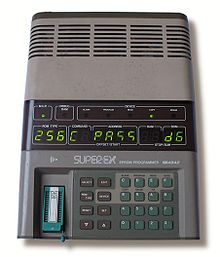Programming device
Programming devices are used to write data into programmable IC components in electronics .
Working principle
Once you have developed a program for a programmable component, for example PROM , EPROM , EEPROM , Flash , PAL , PLD , CPLD or FPGA , the code still has to be incorporated into the component. To do this, the module is first inserted into the zero force base of the programming device . Then the matching connections of the module are brought to the desired potential and the data is "burned in" cyclically in the module by means of a so-called "write current", i.e. permanently defined.
Depending on the application, there are different binary file formats that are transferred directly to the blocks. The most common are Intel HEX , Motorola-S ( S-Record / S19 / SREC), Jedec or the simple binary code . The conversion of the source code ( compilation ) takes place beforehand using software.
construction
Since each type of module to be programmed requires a different wiring of the base, it must be flexibly reconfigured using software. A programming device therefore consists internally of a controllable input / output module, which is connected to the base via so-called pin drivers . Complex programming devices contain their own processor that controls the pin drivers. A pin driver is a circuit that supplies a single connection of the base with logic levels, programming voltages, supply voltages, pull-up / pull-down resistors, ground and clock, depending on requirements. The pin driver is therefore a crucial factor in the versatility and performance of a programmer.
A pin driver is implemented either with an integrated circuit (with new programming devices ) or with individual components such as transistors and resistor networks . The use of an integrated circuit as a pin driver reduces the output capacitance and thereby allows higher clock rates and better signal shapes. In addition, high integration allows the design of small, lighter, network-independent programming devices.
Programming device types
In the past there were programming devices as PC plug-in boards; today, external devices are used almost exclusively. The connection to the PC is made via the parallel printer interface, the USB interface or a LAN or WLAN connection. A distinction is made between gang programming devices for mass production, development programming devices for use in laboratories and small series production, transportable, network-independent programming devices for laboratories and field service, in-system programming devices for programming a component in the operational system and special programming devices that are only used for certain component types are designed.
A programming device is also known colloquially as "Eprommer", "Prommer" or "Brenner". Nowadays the term “burner” is used almost exclusively for CD / DVD writing devices. In addition, the English term "programmer" is often used in German-speaking countries.
